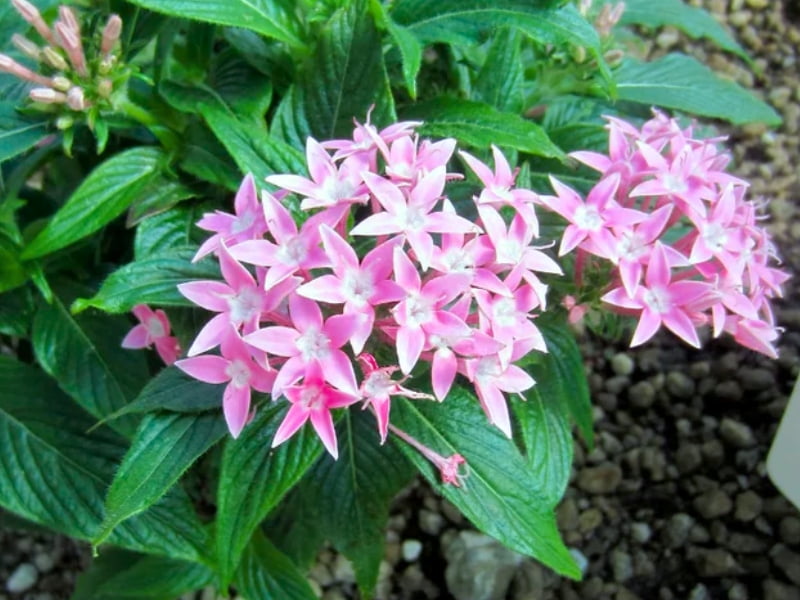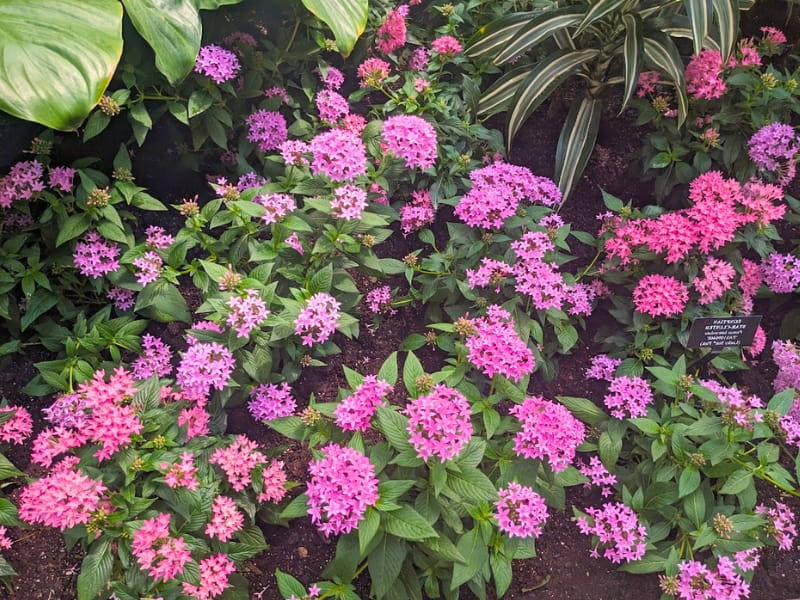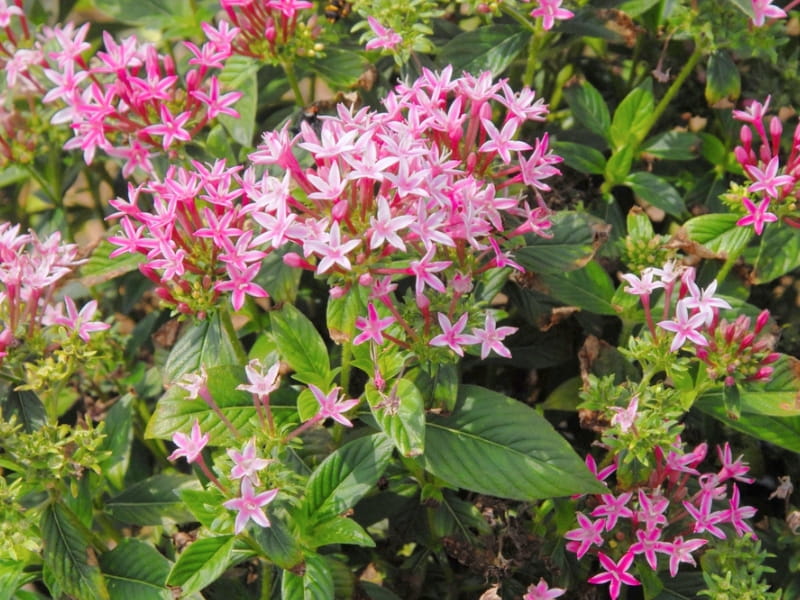Egyptian Star Cluster Flower, also commonly called starflower, Pentas, or star cluster, and botanically known as Pentas lanceolata, are vibrant, heat-loving plants that add a continuous splash of color to gardens and attract beneficial pollinators. These versatile bloomers offer a simple yet effective way to enhance any outdoor space.
At Gardencenterpoint.com, we believe understanding the needs of your Egyptian Star Cluster Flower plants is key to successful gardening, which is why we have designed this guide. Read on for advice on buying, and succesfully growing, your Egyptian Star Cluster.

What is Egyptian Star Cluster Flower?
The Egyptian Star Cluster Flower, native to Africa and Yemen, is a member of the Rubiaceae family. It’s renowned for its clusters of star-shaped flowers that bloom in a range of colors, including red, pink, white, lavender, and even bi-colors. The plant’s vibrant blooms and nectar-rich flowers make it a favorite among butterflies, hummingbirds, and bees, making it a valuable addition to any pollinator garden. The plant gets its name from its five-petaled, star-shaped blooms, which cluster together in dense, rounded heads.
A key characteristic is it’s continuous bloom cycle. Unlike some flowering plants that have distinct blooming seasons, Pentas lanceolata will typically produce flowers from spring until the first frost, provided it receives adequate sunlight and warmth. This makes them an excellent choice for gardeners seeking long-lasting color. It is low maintenance. These plants are relatively easy to care for, making them suitable for both beginner and experienced gardeners. They are tolerant of a range of soil conditions, although they prefer slightly acidic, well-drained soil.
Here is the data that reflects the general growing profile of Egyptian Star Clusters:
| Feature | Description |
| Plant Type | Tender perennial (often grown as an annual in cooler climates) |
| Hardiness Zones | USDA Zones 10-11 (can be grown as an annual in Zones 3-9) |
| Height | 1-3 feet (depending on variety and growing conditions) |
| Spread | 1-2 feet |
| Sun Exposure | Full sun (at least 6 hours of direct sunlight per day) |
| Soil Type | Well-drained, slightly acidic (pH 6.0-7.0) |
| Water Needs | Moderate; allow the soil to dry slightly between waterings |
| Bloom Time | Spring to frost (continuous blooming in warm climates) |
| Flower Colors | Red, pink, white, lavender, bi-colors |
| Foliage | Dark green, lance-shaped leaves |
| Attracts | Butterflies, hummingbirds, bees |
| Uses | Beds, borders, containers, pollinator gardens, cut flowers |
| Propagation | seeds, Stem cuttings. |
| Disease Resistance | Generally resistant to most pests and diseases. Spider Mites may pose a problem. |
Sources:
- University of Florida IFAS Extension: https://gardeningsolutions.ifas.ufl.edu/plants/ornamentals/pentas.html
- Missouri Botanical Garden: https://www.missouribotanicalgarden.org/PlantFinder/PlantFinderDetails.aspx?taxonid=286385
- North Carolina State University Extension: https://plants.ces.ncsu.edu/plants/pentas-lanceolata/
Planting Egyptian Star Cluster Flower
Planting your Egyptian Star Cluster Flower correctly is crucial for its long-term health and blooming potential. Follow these steps for optimal results:
- Timing: The best time to plant Egyptian Star Cluster Flowers is after the last frost in spring, when the soil has warmed up. In warmer climates (Zones 10-11), you can plant them year-round.
- Location: Choose a location that receives at least 6 hours of direct sunlight per day. These plants thrive in full sun.
- Soil Preparation: Amend the soil with compost or other organic matter to improve drainage and fertility. If your soil is heavy clay, consider adding perlite or sand to enhance drainage. A soil pH of 6.0-7.0 is ideal.
- Planting:
- Dig a hole slightly larger than the root ball of the plant.
- Gently remove the plant from its container, being careful not to damage the roots.
- Place the plant in the hole, ensuring the top of the root ball is level with the surrounding soil.
- Backfill the hole with soil, gently firming it around the roots.
- Water thoroughly after planting.
- Spacing: Space plants 12-18 inches apart, depending on the variety and expected mature size. This allows for adequate air circulation, which helps prevent fungal diseases.
Caring for Egyptian Star Cluster Flower
Once established, Egyptian Star Cluster Flowers are relatively low-maintenance. Here are some key care tips:
- Watering: Water regularly, especially during hot, dry periods. Allow the soil to dry slightly between waterings. Avoid overwatering, as this can lead to root rot. A good rule of thumb is to water deeply when the top inch of soil feels dry to the touch.
- Fertilizing: Feed your plants every 4-6 weeks during the growing season with a balanced, water-soluble fertilizer. Alternatively, you can use a slow-release fertilizer at the beginning of the season. Avoid over-fertilizing, as this can lead to excessive foliage growth at the expense of flowers.
- Pruning/Deadheading: Deadheading (removing spent flowers) encourages continuous blooming. Simply pinch or snip off the faded flower clusters just below the flower head. You can also lightly prune the plant to maintain its shape and encourage bushier growth.
- Pest and Disease Control: Egyptian Star Cluster Flowers are generally resistant to pests and diseases. However, keep an eye out for common garden pests like aphids, whiteflies, and spider mites. If you notice an infestation, treat it promptly with insecticidal soap or neem oil. Ensure good air circulation to prevent fungal diseases.
- Overwintering (in cooler climates): In regions where Egyptian Star Cluster Flowers are not hardy, you can overwinter them indoors. Before the first frost, dig up the plants and pot them in containers. Place them in a bright, sunny location and reduce watering. You can also take cuttings in the fall and root them indoors to start new plants for the following spring.
Propagating Egyptian Star Cluster Flowers
Egyptian Star Cluster Flowers can be easily propagated from seeds or stem cuttings:
- From Seeds:
- Start seeds indoors 6-8 weeks before the last expected frost.
- Sow seeds in a seed-starting mix and keep them moist and warm (around 70-75°F).
- Germination typically occurs within 14-21 days.
- Once seedlings have developed a few sets of true leaves, they can be transplanted into individual pots.
- Harden off the seedlings before planting them outdoors after the last frost.
- From Stem Cuttings:
- Take 4-6 inch stem cuttings from healthy, non-flowering stems in spring or summer.
- Remove the lower leaves and dip the cut end in rooting hormone (optional).
- Insert the cuttings into a well-draining potting mix, such as a mix of perlite and peat moss.
- Keep the cuttings moist and in a bright, indirect light location.
- Roots typically develop within 3-4 weeks.
- Once rooted, the cuttings can be transplanted into individual pots or directly into the garden.
Choosing the Right Egyptian Star Cluster Flower Variety
There are numerous cultivars of Pentas lanceolata available, offering a variety of colors, sizes, and growth habits. Here are some popular varieties:
| Variety | Flower Color(s) | Height (inches) | Notes |
| Butterfly Series | Red, pink, white, rose | 12-18 | Compact, well-branched plants; excellent for containers and borders. |
| Graffiti Series | Various | 12-14 | Large flower clusters; known for their vibrant colors and heat tolerance. |
| Lucky Star Series | Various | 10-12 | Very uniform; the first Pentas series bred for 10-hour days or less for early Spring sales. |
| New Look Series | Red, pink, white | 14-16 | Upright habit; excellent for cut flowers. |
| Starcluster Series | Red, pink, white, lavender | 18-24 | Tall variety; good for background plantings. |

Egyptian Star Cluster Flower Uses and Benefits
The Egyptian Star Cluster Flower offers a multitude of benefits, extending beyond its undeniable aesthetic appeal. These plants are far more than just a pretty face in the garden; they contribute to the ecosystem, enhance the beauty of various spaces, and even offer practical uses. Let’s delve into the diverse ways you can utilize and appreciate these remarkable flowers.
Aesthetic Enhancements:
One of the primary uses of the Egyptian Star Cluster Flower is to add vibrant color and visual interest to gardens, patios, and balconies. Their dense clusters of star-shaped blooms create a captivating display, instantly brightening any area. Available in a range of hues, from fiery reds and soft pinks to pristine whites and calming lavenders, they offer flexibility in garden design, allowing for harmonious color schemes or striking contrasts. Whether planted in mass drifts, used as border accents, or showcased in containers, they provide a long-lasting visual treat, often blooming continuously from spring until the first frost.
Pollinator Paradise:
Egyptian Star Cluster Flowers are exceptional pollinator attractants. Their nectar-rich flowers are a magnet for butterflies, hummingbirds, and bees, making them a crucial component of any pollinator-friendly garden. By planting these flowers, you actively contribute to the health and well-being of these vital creatures, which play a critical role in the ecosystem. This is particularly important in urban and suburban areas where pollinator habitats may be fragmented. A study by the University of Florida IFAS Extension highlights the importance of Pentas in attracting various butterfly species, including Monarchs, Swallowtails, and Gulf Fritillaries. (Source: https://gardeningsolutions.ifas.ufl.edu/plants/ornamentals/pentas.html)
Container Gardening Delight:
Their adaptability makes Egyptian Star Cluster Flowers ideal for container gardening. They thrive in pots, providing a portable burst of color that can be moved around to suit your preferences or to follow the sun. This is particularly useful for those with limited garden space or for adding color to patios, balconies, or decks. When used in containers, they often serve as the “thriller” element, providing height and focal interest, while being complemented by “filler” and “spiller” plants.
Cut Flower Charm:
The long-lasting blooms of the Egyptian Star Cluster Flower make them a wonderful addition to cut flower arrangements. Their vibrant colors and sturdy stems ensure they hold up well in vases, adding a touch of garden beauty indoors. Simply cutting the stems when the flowers are fully open and placing them in water can provide days of enjoyment. This also encourages the plant to produce more blooms, extending the flowering period.
Low-Maintenance Landscaping:
Beyond their beauty, Egyptian Star Cluster Flowers are appreciated for their relatively low-maintenance nature. They are tolerant of a range of conditions and require minimal care once established. This makes them a suitable choice for both experienced gardeners and beginners. Their ability to thrive in full sun and tolerate some drought also makes them a practical choice for water-wise gardens.
Therapeutic Benefits:
Gardening itself is known to have therapeutic benefits, and the vibrant colors and lively presence of Egyptian Star Cluster Flowers can further enhance this effect. The act of caring for plants, witnessing their growth, and enjoying their beauty can contribute to stress reduction, improved mood, and a sense of well-being. The presence of butterflies and hummingbirds, attracted by the flowers, adds another layer of enjoyment and connection with nature.
Wildlife Support: As well as being a food source for pollinators, Pentas’ dense foliage also provides shelter for smaller insects, and some birds.
| Use/Benefit | Description | Examples |
| Aesthetic Appeal | Adds vibrant color and visual interest to gardens, patios, and balconies. | Use in borders, beds, containers, hanging baskets; create colorful displays; complement other plants. |
| Pollinator Attraction | Attracts butterflies, hummingbirds, and bees, supporting biodiversity and ecosystem health. | Plant near vegetable gardens to improve pollination; create a pollinator-friendly habitat; contribute to conservation efforts. |
| Container Gardening | Thrives in pots, providing portable color and flexibility in garden design. | Use as a “thriller” plant in container arrangements; add color to patios, balconies, decks; move plants to follow the sun or to protect them from frost. |
| Cut Flowers | Long-lasting blooms are excellent for cut flower arrangements, bringing garden beauty indoors. | Cut stems when flowers are fully open; place in water immediately; use in bouquets, vases, and other floral displays; enjoy the vibrant colors and long vase life. |
| Low Maintenance | Requires minimal care once established, making it suitable for busy gardeners or those new to gardening. | Tolerant of a range of conditions; relatively drought-tolerant; resistant to many pests and diseases. |
| Therapeutic Value | Gardening with these flowers can reduce stress, improve mood, and promote a sense of well-being. The presence of pollinators adds to the therapeutic experience. | Engage in the act of planting, watering, and deadheading; observe the growth and blooming of the flowers; enjoy the presence of butterflies and hummingbirds; connect with nature. |
| Wildlife Support | Provides shelter for many smaller insects and birds. | Provide shelter for toads by positioning rocks or logs in amongst the flower beds. |
In essence, the Egyptian Star Cluster Flower is a multifaceted plant that offers a range of benefits, from enhancing the beauty of your surroundings to supporting the local ecosystem. Its ease of care and versatility make it a valuable addition to any garden or outdoor space. Gardencenterpoint.com encourages you to explore the many ways you can incorporate these stunning flowers into your life.
Troubleshooting Common Problems
While generally easy to care for, Egyptian Star Cluster Flowers can sometimes experience problems. Here are some common issues and solutions:
- Yellowing Leaves: This can be caused by overwatering, underwatering, nutrient deficiencies, or poor drainage. Check the soil moisture and adjust watering accordingly. If nutrient deficiencies are suspected, apply a balanced fertilizer.
- Leggy Growth: This is often caused by insufficient sunlight. Ensure your plants are receiving at least 6 hours of direct sunlight per day. Pruning can also help encourage bushier growth.
- Few Flowers: This can be caused by lack of sunlight, over-fertilizing (too much nitrogen), or not deadheading spent flowers. Ensure adequate sunlight, use a balanced fertilizer, and deadhead regularly.
- Pests: Aphids, whiteflies, and spider mites can sometimes infest Egyptian Star Cluster Flowers. Treat infestations with insecticidal soap or neem oil.
- Diseases: Powdery Mildew is a common fungal disease. If you spot it, act quickly to prevent it spreading by removing any infected leaves, and spraying with a fungicide.

Companion Planting with Egyptian Star Cluster Flowers
Companion planting involves strategically placing plants together to benefit each other. Here are some good companion plants for Egyptian Star Cluster Flowers:
- Salvia: The tall spikes of salvia contrast nicely with the rounded flower clusters of pentas. Both plants attract pollinators.
- Lantana: Lantana and pentas share similar growing requirements (full sun, well-drained soil) and their vibrant colors complement each other.
- Zinnia: Zinnias are another excellent choice for attracting butterflies and their bold colors pair well with pentas.
- Marigolds: Marigolds are known for their ability to repel certain insects, which can benefit nearby plants.
- Herbs (e.g., basil, rosemary): These herbs can help deter pests and their foliage provides a nice contrast to the colorful flowers of pentas.
Frequently Asked Questions (FAQ)
- Are Egyptian Star Cluster Flowers annuals or perennials? They are tender perennials, typically grown as annuals in cooler climates (Zones 3-9). In warmer climates (Zones 10-11), they can be grown as perennials.
- Are Egyptian Star Cluster Flowers deer resistant? While no plant is completely deer-proof, Egyptian Star Cluster Flowers are considered moderately deer resistant.
- Do Egyptian Star Cluster Flowers need full sun? Yes, they require at least 6 hours of direct sunlight per day for optimal blooming.
- How often should I water Egyptian Star Cluster Flowers? Water regularly, allowing the soil to dry slightly between waterings. Avoid overwatering.
- Can I grow Egyptian Star Cluster Flowers in containers? Yes, they are excellent container plants. Choose a pot with good drainage and use a well-draining potting mix.
- How do you get Pentas to bloom? The correct amount of sun, water, fertilizer, and regular deadheading is the key to successful blooming.
Gardencenterpoint aims to be your go-to resource for all things gardening, including information and inspiration for cultivating beautiful and thriving gardens. The platform serves as a central hub, connecting gardening enthusiasts with a wealth of knowledge, practical tips, and reliable resources. Gardencenterpoint does not directly sell plants or products; instead, it provides valuable information and guides users to reputable retailers and nurseries. This ensures that visitors receive unbiased, expert advice and can make informed decisions about their gardening needs.
Gardencenterpoint is not a retailer. It’s a hub that connects you to the best local and online garden centers, providing expert advice, unbiased reviews, and a community of passionate gardeners.
Beyond Egyptian Star Cluster Flowers, explore:
- Other Flowering Plants: Discover a wide variety of flowering plants, from classic roses to exotic orchids. Each plant profile includes detailed care instructions, beautiful photos, and links to reputable suppliers. (Link to internal pages on “Roses,” “Orchids,” “Sunflowers,” etc.)
- Vegetable Gardening: Learn how to grow your own delicious and nutritious vegetables, from tomatoes to lettuce. Access step-by-step guides, troubleshooting tips, and variety recommendations. (Link to internal pages on “Vegetable Gardening,” “Tomato Growing Guide,” etc.)
- Gardening Tools and Supplies: Find honest reviews and recommendations for essential gardening tools, from hand pruners to raised garden beds. (Link to internal pages on “Gardening Tool Reviews,” “Best Raised Garden Beds,” etc. – these would ideally link to affiliate products)
- Gardening Tips and Tricks: Browse a collection of helpful tips and tricks from experienced gardeners around the world. Learn about organic gardening practices, pest control, composting, and more. (Link to internal pages on “Organic Gardening,” “Pest Control Tips,” “Composting Guide,” etc.)
- Landscaping Ideas: Get inspired by stunning landscape designs and learn how to create your own dream garden. (Link to internal pages on “Landscape Design Ideas,” “Small Garden Design,” etc.) Similar plants to consider: Angelonia Butterfly Bush Lantana Salvia

Leave a Reply